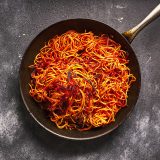After teetering on the brink of ruin, a mound of twirled spaghetti streaked with black bits emerges from Celso Laforgia’s kitchen. The pasta, spaghetti all’assassina, is beyond merely browned—it is charred, barely coated in tomato sauce and flecked with burnt pieces.
Just the way he likes it.
“It’s quite dark, but the pasta has a good balance between bitter, crunchy, crispy and spicy,” says Laforgia, chef of Urban l’Assassineria in Bari, Italy. “That’s the best way.”
Anyone who covets the chewy, overdone corner pieces of lasagna understands. But the scorching of this unique pasta dish—whose name means “killer’s spaghetti” for its menacing amount of red chili spice—is not its only intriguing quality.
Besides a deliberate char that gives the noodles and sauce smoky, bitter notes, the pasta also is cooked “a risottatura” or like risotto, which creates a spectrum of textures from a single ingredient.
Our assassina came out chewy, crispy and deeply flavored. Simply to die for.
After sautéing garlic and fresh red chilies in olive oil, a small amount of tomato puree is cooked until it reduces slightly. Dry spaghetti then is placed in the sauce, where it remains untouched until it sizzles and browns on the bottom.
Then broth made from diluted tomato paste and more puree is poured over the noodles, gradually added ladle by ladle, as you would with rice for risotto. As the pasta absorbs liquid and flavor, the toasted spaghetti softens unevenly, and the sauce mellows the char’s bitterness, bringing it into balance with the tomato’s caramelized natural sugars.
Subtly smoky, spicy and deeply rich with flavor, the pasta is so beloved in Bari that devotees formed the Academy of Spaghetti all’Assassina. In restaurants, members insist that the pasta be cooked in iron or steel pans because they can handle higher heat, and they periodically check up on restaurants to review their cooking technique.
Thankfully, they permit nonstick skillets at home. All the better because with cast iron, we had trouble finding the balance between pleasantly charred and outright burnt. Using nonstick, we got better browning on the noodles by pressing them down with a spatula to increase contact with the skillet.
To make the recipe pantry friendly, we omitted the fresh chilies in favor of crushed red pepper. And though some recipes call for 2 tablespoons of chili flakes plus fresh red chilies, we toned it down to less than a teaspoon. Still spicy but more manageable, our assassina came out chewy, crispy and deeply flavored. Simply to die for.








